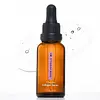What's inside
What's inside
 Key Ingredients
Key Ingredients

 Benefits
Benefits

 Concerns
Concerns

No concerns
 Ingredients Side-by-side
Ingredients Side-by-side

Water
Skin ConditioningPPG-3 Benzyl Ether Myristate
EmollientGlycerin
HumectantSodium Stearoyl Glutamate
CleansingPentaerythrityl Tetraisostearate
EmollientEthyl Macadamiate
Skin ConditioningCaprylyl Glycol
EmollientPunica Granatum Seed Oil
EmollientLeuconostoc/Radish Root Ferment Filtrate
AntimicrobialC10-18 Triglycerides
EmollientMethylheptylglycerin
HumectantRubus Idaeus Seed Oil
EmollientBeta-Glucan
Skin ConditioningCarnosine
Skin ConditioningCentella Asiatica Leaf Extract
Skin ConditioningCamellia Sinensis Leaf Extract
AntimicrobialCeramide NP
Skin ConditioningPichia/Resveratrol Ferment Extract
Skin ConditioningPunica Granatum Extract
AstringentPanthenol
Skin ConditioningSodium PCA
HumectantBisabolol
MaskingHoney
HumectantPhospholipids
Skin ConditioningCassia Angustifolia Seed Polysaccharide
Skin ConditioningCandelilla/Jojoba/Rice Bran Polyglyceryl-3 Esters
EmulsifyingHyaluronic Acid
HumectantEpigallocatechin Gallate
AntioxidantMadecassoside
AntioxidantAsiaticoside
AntioxidantSuperoxide Dismutase
AntioxidantLecithin
EmollientPullulan
Sphingolipids
EmollientOpuntia Ficus-Indica Stem Extract
Skin ConditioningTocopherol
AntioxidantAscorbyl Palmitate
AntioxidantAstaxanthin
Skin ConditioningCetearyl Alcohol
EmollientSclerotium Gum
Emulsion StabilisingSodium Polygamma-Glutamate
Emulsion StabilisingGlyceryl Stearate
EmollientSodium Gluconate
Skin ConditioningXanthan Gum
EmulsifyingHydrogenated Palm Glycerides Citrate
EmollientEthylhexylglycerin
Skin ConditioningHydroxyethylcellulose
Emulsion StabilisingPropanediol
SolventCitric Acid
BufferingSodium Hydroxide
BufferingSodium Dehydroacetate
PreservativePolysorbate 60
EmulsifyingSodium Stearoyl Lactylate
EmulsifyingPolysorbate 20
EmulsifyingSilica
AbrasiveMalic Acid
BufferingPhenoxyethanol
PreservativeWater, PPG-3 Benzyl Ether Myristate, Glycerin, Sodium Stearoyl Glutamate, Pentaerythrityl Tetraisostearate, Ethyl Macadamiate, Caprylyl Glycol, Punica Granatum Seed Oil, Leuconostoc/Radish Root Ferment Filtrate, C10-18 Triglycerides, Methylheptylglycerin, Rubus Idaeus Seed Oil, Beta-Glucan, Carnosine, Centella Asiatica Leaf Extract, Camellia Sinensis Leaf Extract, Ceramide NP, Pichia/Resveratrol Ferment Extract, Punica Granatum Extract, Panthenol, Sodium PCA, Bisabolol, Honey, Phospholipids, Cassia Angustifolia Seed Polysaccharide, Candelilla/Jojoba/Rice Bran Polyglyceryl-3 Esters, Hyaluronic Acid, Epigallocatechin Gallate, Madecassoside, Asiaticoside, Superoxide Dismutase, Lecithin, Pullulan, Sphingolipids, Opuntia Ficus-Indica Stem Extract, Tocopherol, Ascorbyl Palmitate, Astaxanthin, Cetearyl Alcohol, Sclerotium Gum, Sodium Polygamma-Glutamate, Glyceryl Stearate, Sodium Gluconate, Xanthan Gum, Hydrogenated Palm Glycerides Citrate, Ethylhexylglycerin, Hydroxyethylcellulose, Propanediol, Citric Acid, Sodium Hydroxide, Sodium Dehydroacetate, Polysorbate 60, Sodium Stearoyl Lactylate, Polysorbate 20, Silica, Malic Acid, Phenoxyethanol
Ingredients Explained
These ingredients are found in both products.
Ingredients higher up in an ingredient list are typically present in a larger amount.
Glycerin is already naturally found in your skin. It helps moisturize and protect your skin.
A study from 2016 found glycerin to be more effective as a humectant than AHAs and hyaluronic acid.
As a humectant, it helps the skin stay hydrated by pulling moisture to your skin. The low molecular weight of glycerin allows it to pull moisture into the deeper layers of your skin.
Hydrated skin improves your skin barrier; Your skin barrier helps protect against irritants and bacteria.
Glycerin has also been found to have antimicrobial and antiviral properties. Due to these properties, glycerin is often used in wound and burn treatments.
In cosmetics, glycerin is usually derived from plants such as soybean or palm. However, it can also be sourced from animals, such as tallow or animal fat.
This ingredient is organic, colorless, odorless, and non-toxic.
Glycerin is the name for this ingredient in American English. British English uses Glycerol/Glycerine.
Learn more about GlycerinHydroxyethylcellulose is used to improve the texture of products. It is created from a chemical reaction involving ethylene oxide and alkali-cellulose. Cellulose is a sugar found in plant cell walls and help give plants structure.
This ingredient helps stabilize products by preventing ingredients from separating. It can also help thicken the texture of a product.
This ingredient can also be found in pill medicines to help our bodies digest other ingredients.
Learn more about HydroxyethylcellulosePolysorbate 20 is made by combining ethoxylation of sorbitan, ethylene oxide, and lauric acid. It is a mild cleansing agent, surfactant, and emulsifier.
As a surfactant, it helps collect dirt and oils for washing. Emulsifiers prevent oils and water from separating.
Polysorbate 20 also adds scent to a product. Since it is made using sorbitol, it has a sweet scent. Sorbitol can also be found in fruits such as apples and peaches.
The lauric acid used to create Polysorbate 20 is often derived from coconuts.
Polysorbate 20 may not be fungal acne safe.
Learn more about Polysorbate 20Water. It's the most common cosmetic ingredient of all. You'll usually see it at the top of ingredient lists, meaning that it makes up the largest part of the product.
So why is it so popular? Water most often acts as a solvent - this means that it helps dissolve other ingredients into the formulation.
You'll also recognize water as that liquid we all need to stay alive. If you see this, drink a glass of water. Stay hydrated!
Learn more about Water